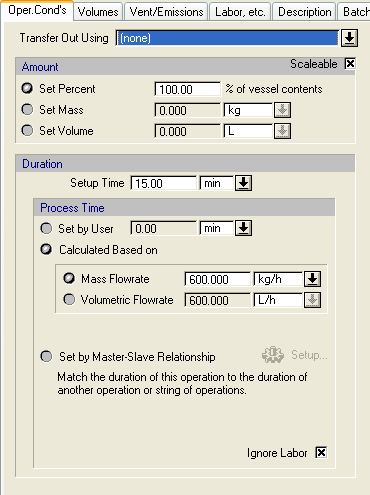

The following table shows a brief description of the variables appearing in this tab. The table also displays their default values and their generally acceptable range:
|
Variable |
Default Value |
Range |
|
|
||
|
○ Transfer Out Using Port / Stream |
<None> |
Any Output Port |
|
◙ Percent (% of vessel contents) |
100.0 |
0-100 |
|
◙ Mass (kg) |
0.0 |
Positive |
|
◙ Volume (L) |
0.0 |
Positive |
|
○ Setup Time (min) |
15.0 |
Positive |
|
◙ Process Time (min) |
0.0 |
Positive |
|
◙ Mass Flowrate (kg/h) |
600.0 |
Positive |
|
◙ Volumetric Flowrate (L/h) |
0.0 |
Positive |
|
○ Ignore Labor? |
Yes |
Yes/No |
Symbol Key: ○ User-specified value (always input); ● Calculated value (always output); ◙ Sometimes input, sometimes output
The following list describes the available specification choices in this tab; for more details on how these are implemented, see Transfer Out: Modeling Calculations.
•Transfer In stream...
You must always select a transfer out stream. The transfer stream must be one of the output streams of the procedure that this operation is participating. Multiple transfer out operations can use a transfer out stream. In such a case, if you visit the dialog of that stream, you will see the sum of all materials transferred using that stream.
•Duration options...
The duration of the operation can be calculated by the following ways:
a) Set directly the user
b) Calculated based on a user-specified transfer-in mass or volumetric flow rate, or
c) Tied up to another operation or operation sequence by exploiting the Master-Slave relationship. If you introduce a master-slave relationship, the program will match the setup time, the process time and the turnaround time of this operation (the ‘slave’) with the corresponding times of the reference operation (the ‘master’ operation). For more details on how to setup a master-slave relationship, see The Scheduling Tab.
● Pull Out